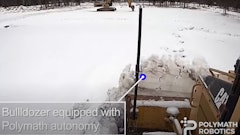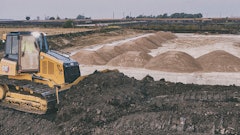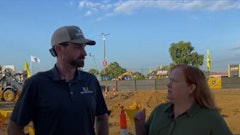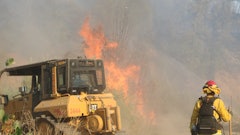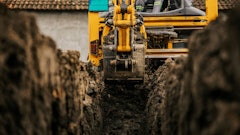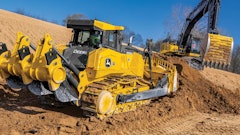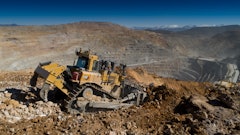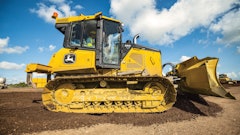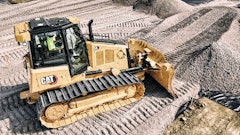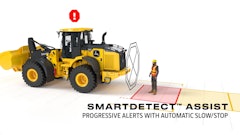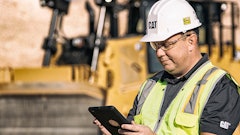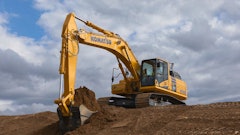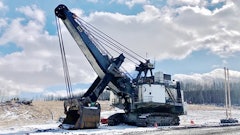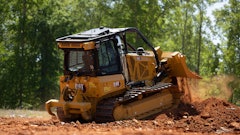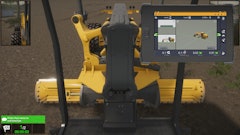
When it comes to fine grading, automated grade control systems have certainly commanded a lot of attention - and for good reason. They can enhance efficiency, reduce rework and enable even less experienced operators to achieve grade more quickly. Yet, finish work typically encompasses only a small portion of a dozer's hours on a project.
"It depends a lot on the application, but you will spend probably 90% of the time doing what I would call 'material balancing' and rough grading to get things generally laid out according to the finished design plan," says Bruce Unger, New Technology Black Belt, Heavy Construction and Mining Division, Caterpillar Inc. "It's really when you only have the last couple inches left that you put it into automatic mode and make that final pass to get to that final spec."
For the largest percentage of a dozer's time on the job, it's up to the operator to take control. Thankfully, this has become much easier given the added "brains" incorporated into today's dozer designs, which enable these heavyweights to do some of the thinking for themselves.
An electronic shift
With the introduction of stricter emissions requirements, engine suppliers have been required to incorporate more sophisticated electronics into engine control systems. A side benefit is these electronics tend to facilitate better communication between various operating systems of the machine.
"The electronics are mandated to a point where it's impossible to meet emission levels at certain horsepower levels without fully electronically controlled engines," says Bernard Winker, manager of marketing and engineering services, Dressta North America. Depending on the powertrain system, this also means the engine and powertrain are able to communicate more effectively to control other machine functions.
"Most machines today have onboard computer technology, where the engine and transmission 'talk' to each other and make automatic adjustments to allow the machine to work at optimum efficiency," says Dan Drescher, product marketing manager - crawlers, John Deere Construction & Forestry.
For example, the engine and hydraulic control units on many of today's dozers work together to adjust operating rates and performance characteristics. "What you have today is the ability to adjust the speed ratios of your transmission, forward and reverse," Drescher notes. "Essentially, you tell the machine how fast you want to go - the maximum speed for a certain operation - and it will adjust up and down based on the load you have on the blade and the ripper."
"If an operator starts loading the tractor in second gear, for example... the transmission will determine that it is more efficient to kick down to first gear," Unger adds, "and it will automatically do that."
This takes the impetus off the operator to determine when it's time to upshift or downshift. "On some of our larger tractors... we let the computer decide when the torque converter locks up, because we find that the computer does a much better job of sensing conditions and when things should happen," says Les Scott, product manager - dozers, Komatsu America. "The guy in the seat has to feel or hear the engine lug down... He has to pick up some 'sign' that he's starting to overtax the tractor in that particular gear.
"By measuring ground speed and engine load, the [transmission] controller will shift at a much more opportune time to maintain your dozing production," he states.
"It's almost like an automatic-style transmission in a dozer," Drescher comments. "You don't have to think about shifting gears. It's always going to be at its maximum productive level, and you can focus on adjusting the load or maneuvering the tractor."
Fingertip functionality
The growing shift from pilot to electrohydraulic controls is enabling suppliers to further simplify dozer operation. Gone are most of the manual control levers in favor of multi-functional joysticks.
"Rather than steering levers and transmission levers, we have incorporated all the steering functions, as well as all the transmission and shift functions, into the joystick," Winker points out. "This has been enhanced by the addition of electrohydraulic systems. Before, our controls were all purely pilot-operated hydraulics. Now, we've added electronics to the systems so that we can effect a gear change by just pushing an upshift or a downshift button."
Hydrostatic transmissions readily lend themselves toward joystick operation. But even traditional torque converter powertrains have evolved, says Winker. "Before, the operator relied on an average of three levers for motion control, forward and reverse, left and right steering and transmission speed changes," he notes. "That's pretty much all combined into one now."
Steering clutches and brakes have been virtually eliminated. "Most machines are controlled with a single lever for direction, steering and speed in one hand," says Drescher. "Your other hand would be on your hydraulic control for your dozer blade.... So you really have a control system that allows you to run mainly with your hands. You don't need three hands and four feet, like you might have in the past. It's very simple and more operator friendly."
Certain functions are also being moved from the control console and placed on the joysticks. For example, shift buttons built into the joysticks enable upshifting or downshifting at the touch of a thumb. A similar approach has been taken with blade tilt and pitch control - operators are able to make blade adjustments at the push of a button.
"You can activate/deactivate or modify those types of functions all without taking your hands off the implement controls," Unger points out. "You're not taking your hand off to push some button on the right-hand console or the front dash." This means the operator can maintain sight of the blade and retain full control of the machine at all times.
Electrohydraulic benefits
According to Unger, the primary reason behind the move from pilot controls to electrohydraulics is automated grade control.
"That's really the sole purpose of making that transition," he asserts, "to facilitate automation features and give an easy way to get into the system and control the implements, engine, transmission, etc."
"With the electrohydraulic controls on board, it's easier to integrate grade control into the machine," Drescher agrees, "because the GPS system or the laser [can] send a signal to the grade control sensor that's on the tractor." The sensor in turn communicates with the electrohydraulic valve to control the blade functions.
Electrohydraulics have other benefits, as well. For example, they enable what's called bi-directional shift. "When you flip to reverse, it will automatically put you in second gear," says Unger. "It's configurable - you can pick whichever gear you want - and it will automatically [select a] corresponding forward gear when you select forward, and a corresponding reverse gear when you shift into reverse."
You also have the ability to adjust how aggressive or soft the dozer will steer. "If you were in an application where, let's say, you're in deep mud and you need a power boost in the turn to maneuver in those kinds of underfoot conditions, you can dial that in," Drescher points out. "The computer technology and electrohydraulic controls allow you to make adjustments that weren't possible in the past."
Of course, there are some sacrifices associated with the switch to electrohydraulics. For one, they add cost and complexity to the machine. They also lessen an operator's ability to perceive what's happening at the edge of the blade.
"The primary thing operators will tell you on an electrohydraulic machine is you lose 'feel', because your handle is no longer mechanically connected to the blade or hydraulic system," says Unger. "If your blade comes up against a hard object or there is a lot of load on your blade, with a pilot-based handle, or certainly a direct spool actuation, you feel that additional pressure... With electrohydraulics, it's all sensors and electronics, so you lose some of that feel."
Yet, the gains tend to make up for any losses rather quickly. "In the greater scheme of things, if you have automation coupled with [electrohydraulics], you gain back the productivity and then some," Unger states.
Lowering the learning curve
The clear benefit of the inborn intelligence of today's dozers is ease of operation with less operator input required.
"The operator doesn't have to work as hard during the day," says Scott. "He can actually respond faster to what he may see needs to be done or what correction needs to happen [because] the machine is more responsive. The bottom line is he's more productive at the end of the day."
A slightly less quantifiable, but equally valuable benefit is reduced lead time for newer operators to come up to speed with these machines. "They're not as complicated," says Drescher, "so the learning curve is a lot shorter."
Although Drescher emphasizes the importance of having adequate "dirt-moving knowledge" to be truly proficient with a dozer, he believes today's technology makes it easier for operators of all skill levels to concentrate on the task at hand.
"It is easy to say that a less skilled operator today can operate a machine a little easier than they could in the past," he says. "And a very good operator can make it operate even better, because they don't have to worry about the pressure of getting to final grade as much, since they have onboard systems like grade control or pressure-sensing hydraulics that allow them to get to those tolerances a lot quicker."
If an operator can focus less on the functions of the machine, it means he or she can devote more attention to getting the job done as quickly and efficiently as possible. "You can maneuver where you want to be more quickly and get there faster, and you can start working quicker compared to past units," Drescher states. "All of these things combine to make dozers more nimble than past machines and overall more productive, because you're working more and positioning less."
High-tech Blade Control
As with other dozer operating systems, there has been a continuing evolution in implement controls. Perhaps nowhere is this seen more clearly than on large, high-production models.
For example, Komatsu offers dual tilt and pitch functions on its largest crawler tractors. "You can equip the machine so you can pitch the blade forward to make a more aggressive cutting angle when you start to doze, then change the pitch of the blade again during the dozing cycle and slowly move it back to more of a carry position," Les Scott explains.
Through the carry process, the blade is laid all the way back - acting almost like a scoop shovel - to enable it to carry a much larger load out front, Scott continues. Once you reach the dump area, you can then pitch the blade forward with the push of the blade control button and eject the dirt off the blade.
Caterpillar takes this even further with its Auto Blade Assist, which is essentially an automatic blade pitch control. According to Bruce Unger, you simply push a button to indicate you're in the loading/carry/spreading cycle, and the system automatically adjusts blade pitch and/or blade height, depending on how much automation has been built in. "In the case of Auto Carry, it will automate blade height during the carry part of the cycle," he says.
When operating a dozer in manual mode, an operator can make up to as many as 60 corrections per minute, Unger points out. "When it's in Auto Carry mode, an operator will typically create only one or two corrections per minute," he states. "It allows the operator to take his hand completely off the joystick, and it will control the blade throughout that portion of the cycle."
Admittedly, such advanced blade control systems are targeted to mining and other high-production applications. Yet, as demand for more sophisticated controls continues, you may start to see at least variations of these systems funnel down into smaller machine sizes.
"There are various bits and pieces that we are considering taking out of Auto Carry and utilizing in smaller machines to help reduce operator fatigue and help improve productivity and efficiency of the machine," says Unger. "We see it progressing down and mutating into other variations of the same theme."






